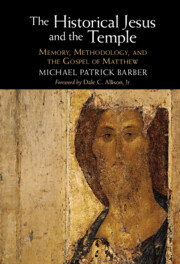3 results

The Historical Jesus and the Temple
- Memory, Methodology, and the Gospel of Matthew
-
- Published online:
- 27 April 2023
- Print publication:
- 13 April 2023
2 - The Demise of “Authenticity” and the Challenge of Methodology
-
- Book:
- The Historical Jesus and the Temple
- Published online:
- 27 April 2023
- Print publication:
- 13 April 2023, pp 20-42
-
- Chapter
- Export citation
7 - Memory
-
-
- Book:
- The Cambridge Handbook of the Intellectual History of Psychology
- Published online:
- 18 May 2019
- Print publication:
- 16 May 2019, pp 165-215
-
- Chapter
- Export citation

